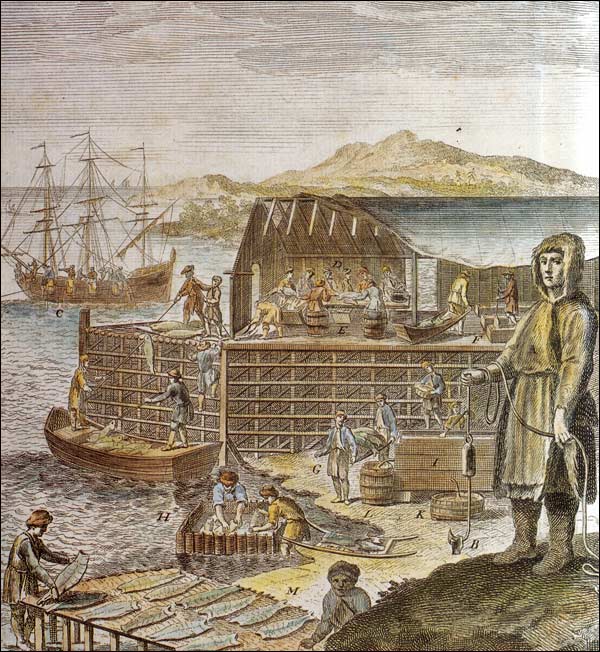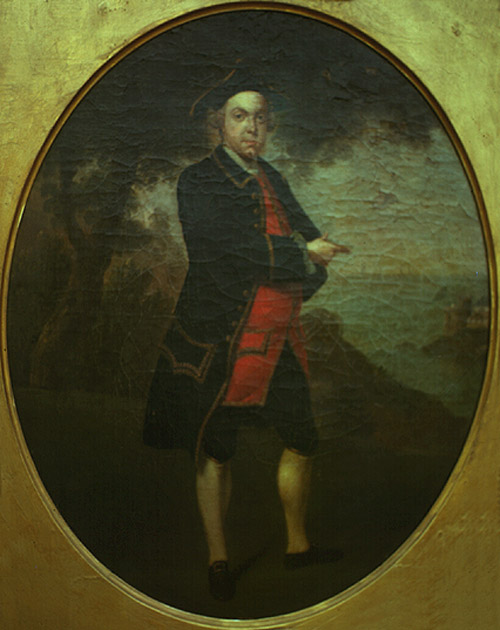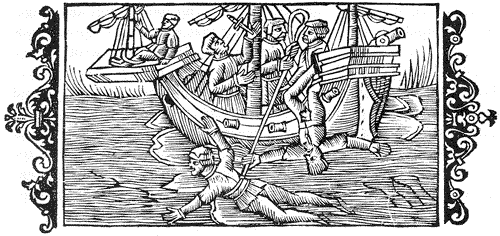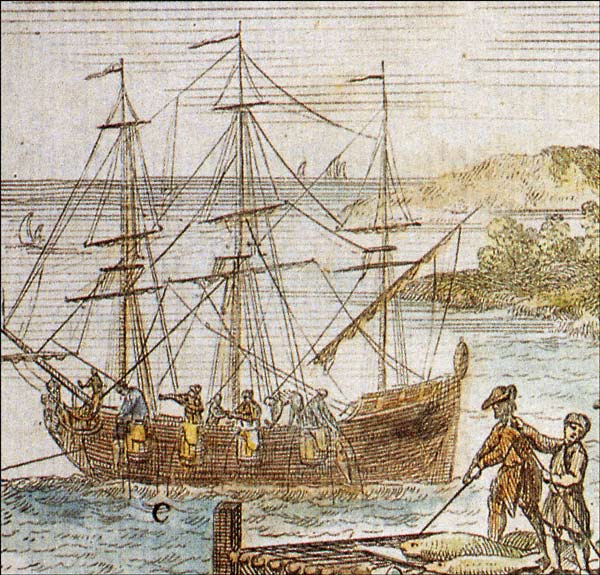Fishing Admirals
When the island of Newfoundland came to the attention of the European nations of the 16th century, it was considered largely for its economic possibilities. The vast fishery set up along its coastline sparked interest from several countries, such as France, Spain and England.

Translation of the legend which appears in the banner (not shown):
A. The Habit of ye Fishermen
B. The Line
C. The Manner of fishing
D. The Dressers of ye Fish
E. The Trough into which they throw ye cod when dressed
F. Salt Boxes
G. The Manner of Carrying ye Cod
H. The Cleansing of ye Cod
I. A press to extract ye oyl from ye Cods Livers
K. Casks to receive ye Water & Blood that comes from ye livers
L. Another Cask to Receive ye Oil
M. The Manner of Drying ye Cod
However few legitimate claims were made on the island; it was considered a commercial enterprise above all else. These claims, such as those made by Sir Humphrey Gilbert in 1583, were not taken seriously by other European powers who fished in the area. No government wanted to risk hurting the fishery by placing a permanent settlement on the island. As a result, Newfoundland became the dominant stomping grounds of European fishermen. During their stay in the migratory fishing season, these men basically had total control of the island. Furthermore, as they had absolute rule over the terrain, they precipitated the need to govern themselves. Thus, the position of the fishing admiral was created in Newfoundland.

Though not a naval admiral in any sense of the word, the 'fishing admiral' was simply a label assigned to the first ship captain who entered the harbour at the start of the fishing season. He also had the first choice of fishing rooms. The 'vice-admiral' and the 'rear admiral' were the second and third ship captains who entered the harbour respectively. It was their job to assist the fishing admiral in his duties (Rowe 104). The West Country fishers often called the admiral "the Lord," and naturally the vice-admiral became "the Lady." Many place names around the Newfoundland coast reflect this - Lord's Cove, Lady Cove, and Admiral's Cove. These places would have all been the best fishing rooms in the locality.
The selection of the fishing admiral seemed to be a matter of convenience, more than anything else. Although reaching a harbour first may have been the easiest way to fill the seat, it was far from the most democratic. The captain who arrived first was not always the most qualified for the job.
Customary Law
Because no formal institution of law had been devised on the island, custom dictated the role of the fishing admiral for much of its existence. The admiral's status and rule in Newfoundland were based on abstract notions of law that were conceived over a long period by the fishermen and seamen themselves. The admirals were supposed to enforce the law, as well as the orders and rules governing the fishery. Although this judicial role was largely based on custom, its practical implementation was based largely upon the size and power of admiral's ship and crew. A well-armed ship and large crew were important factors for any fishing admiral wishing to enforce his authority. An admiral lacking these assets could be ignored by the other captains and, therefore, his rule would be completely ineffective (Matthews 68). In effect, "might made right."
The fishing admiral was responsible for quelling disputes between the fishermen and dealing with petty crimes such as theft and vandalism. More serious offenses, like murder, were not within his jurisdiction and instead had to be tried back on English soil as soon as possible. And important civil cases - concerning contracts, for instance -were also settled in England after the fleet returned. However, few crimes as serious as murderers were ever convicted. The expense of travelling to England with the convict and witnesses outweighed the demand for justice; most fishing admirals did not bother with the formalities of a murder trial. Instead, they allowed most culprits to avoid persecution (Matthews 144).
The fact of the matter was that fishing admirals generally did not dispense proper justice. First and foremost, their reason for being in Newfoundland was to catch an expected quota of fish for their ship owners and English merchants who had hired them. Most fishing admirals may not have cared about any criminal infractions, so long as this did not affect the work of his ship and crew. It is possible that some relinquished the title to one of their deputies, or to another captain, so as to avoid unnecessary delays to their fishing. Nonetheless, the fishing admirals who continued as such had little choice but to act as the impromptu court of the land. When a person was convicted, the punishment handed out depended on several factors: the severity of the crime; the character of the offender(s); and the personality of the fishing admiral himself.
Fishing Admiral Stereotype
Fishing admirals have often been stereotyped as tyrannical sadists - men who beat and punished with excessive force those they found guilty. They were seen as brutish and cruel men who understood the whip better than reason. However, such an image is inaccurate. Severe corporal punishment was a common and accepted punishment in the early modern world. And it was certainly the most efficient means of justice known in Newfoundland, where no jails existed and fines were difficult to collect. Most fishermen did not carry cash with them and generally the ship captains would have been reluctant to pay for offenses committed by their crew members. Sentencing a man to ten lashes across the back with a leather strap for the theft of supplies was perhaps the easiest way to deal with the crime.

It should be realized that these men had no legal training. They were sent to Newfoundland to catch fish. To judge criminal offences was often time consuming and therefore costly. The threat of corporal punishment was the easiest way for the fishing admirals to maintain control over their crews.
Resistance to Settlers
The fishing admiral system was a product of the migratory fishery and generally took no account of the existence of settlers. The issue of permanent settlement on Newfoundland was never a serious problem until later in the 17th century. The island was largely considered a profit making venture; a place of business where colonial encroachment would have been disruptive to the migratory fishery (Cell 1982 5). While most attempts at colonization had failed (Rowe 88), there were some that were minor successes. And those few successful attempts are what kept European interest in the island alive.
Settlement of any kind was usually looked down upon by the fishery and fishing admirals may have sometimes acted harshly in their dealings with prospective settlers. Following the demise of many colonies, the British government grew somewhat apprehensive about colonizing the area. Because the fishery took precedence in Newfoundland, the government took certain measures to discourage settlement since it would create the need for a year round residential government. They believed that this would eventually replace British control of the fishery.
Western Charter
The rights and authority of the fishing admirals were finally recognized by the British government under the Western Charter of 1634. Under this charter, the fishing admiral system received formal recognition, although it never worked well in practice. The West Country justices who were responsible for deciding the more serious disputes were often involved in the fishery themselves and thus were far from impartial. And it was still almost impossible to deal with capital crimes since in such cases it was necessary for the admiral to bring the prisoner as well as two witnesses - at their own expense - to England for trial. As a result, only a handful of criminals were ever convicted under these rules and many abuses occurred since admirals often adjudicated cases in which their own interests were involved.
The Western Charter also severely limited the rights of any settler who was not associated with the fishery. Among other things, it stipulated that "no planter should cut down any wood, or should plant within six miles of the sea, and that no seaman or fisherman should remain behind after the fishing was ended (Neary 33)." This effectively barred settlers from the migratory fishery, which was the largest industry in Newfoundland.
Settlement
Although colonization was unfavourable within some political circles, there was still a desire to settle on the island. The main argument for English settlement was that it would provide the key to controlling the fishery and keeping it away from other European nations, especially the French (Matthews 86). But opponents stressed that colonization would destroy the migratory fishery and turn Newfoundland into another New England. As the population increased in New England, colonists had usurped direct control of its migratory fishery from Britain. The thought of losing control over more fishing grounds struck a chord in the English Parliament and helped to gain support for the anti-settlement argument (Matthews 107).
It is believed that the fishermen also did their part to discourage settlement. Settlers were barred from the best fishing stages. Fishing admirals would often see to it that the possessions of the settlers were either confiscated or destroyed. Settlers were also terrorized to the point where many were forced to move inland and away from the coastline (Chadwick 6). They could not do much to stop this treatment because the only government on the island was the fishing admiral who was fundamentally against settlement in the first place.
However, the cry for settlement could not be muffled for long. As the population steadily grew, the demands for protection against fishermen grew as well. The British government had to yield to these demands because it realized their dominance of the migratory fishery could be better ensured through colonization rather than the old method of commuting back and forth to the island during the seasonal fishery (Cell 1969 108).

King William's Act
In 1699 the British government created the King William's Act which stipulated that the commander of the naval convoy accompanying the English fishing fleet would act as an appeal judge to the decisions of the fishing admirals. The appeal judge would deal with the charges against fishing admirals put forward by ship captains, seamen, and other inhabitants of the island. For the first time, at least in theory, the rule of the fishing admirals came under direct supervision. Also, during this year, the British promoted the establishment of an island government without formal rule.
The First Governor
However, since the law was unenforceable, the situation in Newfoundland became increasingly chaotic. The fishing admirals were not interested in maintaining order and the convoy commanders were powerless. The English government had no choice but to assign a governor to the island of Newfoundland in 1729 and the commodore of the naval squadron supervising the fishery was appointed to the additional titles of governor and commander-in-chief. Until 1817, the governor ruled on a seasonal basis during which he arrived in the Spring and left in the Fall. During this time, he sent out his subordinate naval officers to hold court in the distant harbours and ports around the island and appointed magistrates to hear cases all year round, not just in the winter months after the admirals had departed (Neary 43). Effectively, the rule of the fishing admiral was now dead.
The King William's Act was not amended and the fishing admiral system was never abolished through legal procedure, but by the early 1730s the power of the fishing admirals had been replaced by magistrates. This placed the administration of law and government upon a much firmer basis. The fishing admiralty had endured for more than a century despite its imperfect system of rule because it had maintained order on an island where no formal regulations existed.




